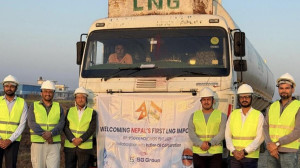Money
Nepal’s economy likely to grow by up to 6.2pc: ADB
The country’s economy may expand by up to 6.2 percent in the current fiscal year led by a bumper agricultural output, prospects of a pick-up in post-earthquake reconstruction works, and an improving investment climate, the Asian Development Bank (ADB) has said.
The country’s economy may expand by up to 6.2 percent in the current fiscal year led by a bumper agricultural output, prospects of a pick-up in post-earthquake reconstruction works, and an improving investment climate, the Asian Development Bank (ADB) has said.
The above average monsoon rains and the smooth availability of agricultural inputs, particularly chemical fertilisers, is likely to significantly boost agricultural output, which makes a contribution of around 33 percent to the gross domestic product.
Also, growth in wholesale and retail trade activities, which make the second largest contribution to the GDP, is expected to be higher than in the last two years, because of hike in consumption due to steady, but slower, growth in remittance inflows, says the ADB’s latest Macroeconomic Update.
This will contribute to the economic growth as well, albeit wholesale and retail trade activities are not going to be as robust this year as in 2013-2014 because of deceleration in remittance inflow, adds the report. However, notable improvement in power supply, resumption of manufacturing activities following the lull after the earthquakes in 2015 and supplies disruption in 2016, and pick up in post-earthquake reconstruction works are expected to boost industrial output.
Considering these scenarios, the economy, according to the ADB, will grow by 6.2 percent in 2016-17. But headwinds from the demand dampening effect originating from deceleration of remittance inflows, demonetisation shock in India and some degree of political instability in the Tarai, may limit economic growth to 5.2 percent, warns the ADB.
Both the economic growth scenarios presented by the ADB are higher than its previous forecast of 4.8 percent.
“To further accelerate economic growth, Nepal must take concrete steps to increase domestic and foreign investment,” said Kenichi Yokoyama, country director for the ADB’s Nepal Resident Mission. Nepal needs much higher domestic and foreign investments in priority sectors to achieve its economic potential, says the report.
Foreign direct investment (FDI) flows to Nepal over the last decade, for instance, have remained below 1 percent of the GDP. International comparison shows that Nepal lags behind many peer countries in terms of attracting foreign investments.
To turnaround the existing situation, Nepal could introduce further reforms especially to address the de-facto practices and procedures governing foreign investment, mainly related to approval, visa and repatriation of earnings, the report says.
Introducing an automatic route for foreign investment will be a step change in the right direction, adds the report. “Also, a more pragmatic approach against placing limits on the minimum size of FDI could be adopted and more effort needs to be made to protect intellectual property rights.”
Similarly, serious efforts, including legal measures, are needed to create an environment of healthy industrial relations in the country, says the report, adding, “Finally, a robust and periodic evaluation of industrial promotional schemes needs to be introduced to make effective use of such schemes.”




 8.12°C Kathmandu
8.12°C Kathmandu












